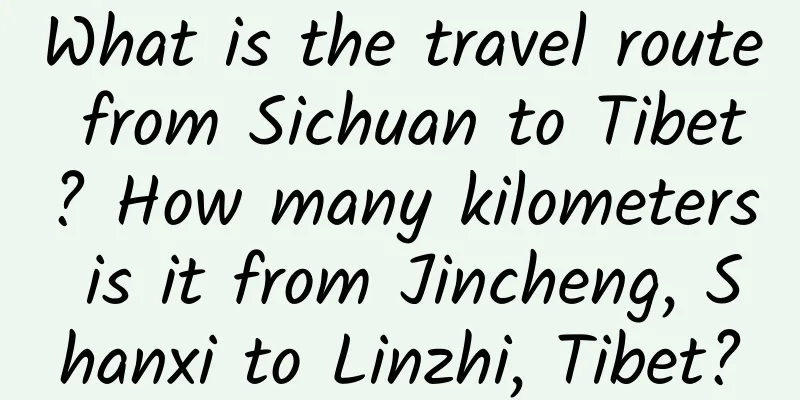What is the travel route from Sichuan to Tibet? How many kilometers is it from Jincheng, Shanxi to Linzhi, Tibet?

|
Tibet is a place of religious belief. Below the Dalai Lama and the Regent is the government administrative agency, called "Kashag" in Tibetan. There are two main offices below the Kashag, one is "Yicang", which means the Secretariat, and the other is "Zaikang", which means the Audit Office. Except for "Yicang" and "Zaikang", officials of various government administrative agencies are monks and laymen, and the same is true for local officials such as various kichas and zongs. The mysterious Tibet attracts many people. So what is the tourist route from Sichuan to Tibet? How many kilometers is it from Jincheng, Shanxi to Linzhi City, Tibet? Let's take a look at the introduction of Encyclopedia Knowledge Network below! Contents of this article 1. What is the tourist route from Sichuan to Tibet? 2. How many kilometers is it from Jincheng, Shanxi to Linzhi, Tibet? 3. How many kilometers is it from Kangding to Qamdo, Tibet? 4. Social hierarchy in ancient Tibet 1What is the tourist route from Sichuan to Tibet?Sichuan-Tibet Southern Line. The specific routes are: Chengdu, Ya'an, Tianquan, Luding, Kangding, Xinduqiao, Batang, Mangkam, Zuogong, Basu, Bomi, Bayi, and Lhasa. The cost of self-driving car is about 6,000 yuan, including food, accommodation, fuel and tolls. 2How far is it from Jincheng, Shanxi to Linzhi, Tibet?If driving: Route 1: The total length is 2784.3 kilometers. It starts from Jincheng and passes through Lianhuo Expressway, Beijing-Kunming Expressway, Chengmian Expressway, Ya'an-Kangding Expressway, Shanghai-Nie Line, and Zamu East Road to reach Linzhi City, Tibet. It takes 49 hours and 35 minutes. Route 2: The entire journey is approximately 2,796.1 kilometers. It starts from Jincheng and passes through the Jinhou Expressway, Beijing-Kunming Expressway, Cheng-Mian Expressway, Ya'an-Kangding Expressway, Shanghai-Nie Line, and Zamu East Road to reach Linzhi City, Tibet. It takes 49 hours and 27 minutes. If you are travelling by public transport: By train: The total journey is 2,850.6 kilometers. Take the train from Jincheng Station to Zhengzhou Station, then take the train from Zhengzhou Station to Nagqu Station, and finally take the train from Nagqu Station to Nyingchi City. It takes 43 hours and 41 minutes. 3How many kilometers is it from Kangding to Qamdo, Tibet?1. The entire journey from Kangding to Qamdo is about 959 kilometers; 2. Driving route: Kangding Municipal People's Government, Ganzi Tibetan Autonomous Prefecture, drive from the starting point to the south, drive 60 meters, turn right and enter the Tea Horse Road; 3. Drive 2 km, turn slightly left to 318, drive 87 km along 318, and go straight into Gaolusi Tunnel; 4. Drive 5 kilometers along Gaolusi Tunnel, go straight to 318, drive 42 kilometers along 318, and go straight to Yajiang Tunnel; 5. Drive 270 meters along Yajiang Tunnel, go straight to 318, drive 960 meters along 318, go straight to 318; 6. Drive along 318 for 29 kilometers, turn left onto 318, drive along 318 for 96 kilometers, and go straight into Litang Tunnel; 7. Drive along 318 for 88 km, turn right to 501, drive along 501 for 246 km, turn left to 317, drive along 317 for 181 km, and turn right; 8. If you drive in Qamdo, drive 80 meters, turn left in front and drive 20 meters, turn left and drive 60 meters to reach the end point, Qamdo Administrative Office. 4Social hierarchy in ancient TibetThe social hierarchy in old Tibet was very strict. The top class was the monks, also known as lamas, followed by the nobles, and the lowest class was serfs and slaves. The government officials were composed of prominent monks and nobles, who were the ruling class in Tibet. Serfs and slaves were the ruled class and had no political status. The highest religious and secular leader was the Dalai Lama, who held both political and religious power. Before the Dalai Lama took power, political and religious power was in the hands of the regent. Tibet's social and political system was strictly hierarchical and ruled by a special theocratic official system, with the vast majority of serfs and slaves having no rights. |
<<: Where is the best place to go to Tibet? What is the route from Hangzhou to Tibet?
>>: What was the social hierarchy in ancient Tibet? Why is Nepal's population larger than Tibet's?
Recommend
Mycoplasma vaginalis
The human body can be infected in many parts, and...
Ovulation period bleeding chart
Many women experience ovulation bleeding during t...
Picture of 34-week fetus in the belly
The most important way for the fetus to obtain nu...
Taboos of wearing long skirts with shoes
There are some things to pay attention to when ma...
What is the Dragon Blood Tree? What are the varieties of Dragon Blood Tree?
Dragon Blood Tree, leaves mostly grow at the top ...
What is the reason for less menstrual flow at 46 years old?
What causes a 46-year-old to have less menstruati...
Silver Age Science | Why are the elderly prone to insomnia?
Pay attention to the life of the elderly and watc...
How to maintain the uterus after giving birth?
Childbirth is a relatively common physiological p...
Can I eat fennel seeds during my period?
Menstruation can be said to be the most distressi...
Pay attention to baby skin problems in summer to protect your baby from "skin pain"
In summer, mothers can finally change their child...
What are the factors that affect women's private health?
Women's bodies need to be well protected to a...
4 months pregnant woman suddenly has severe back pain
Pregnant women are bound to suffer from back pain...
How to do strength training for women?
As people's awareness is changing, more and m...
Why do I have lower abdominal pain after sex?
Some people will experience different kinds of ab...
How many days after the period is the ovulation period?
Ovulation occurs during female puberty, generally...









